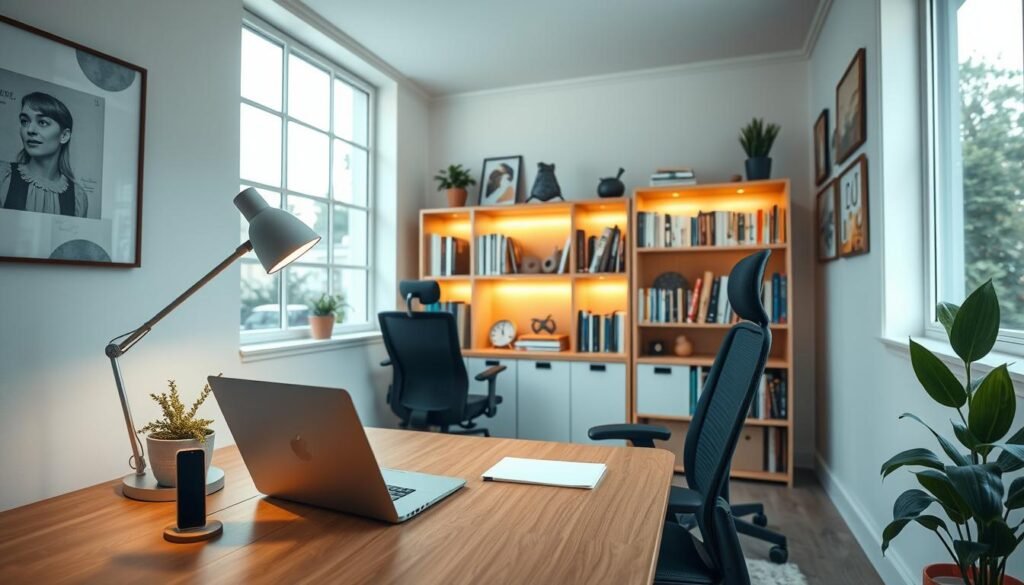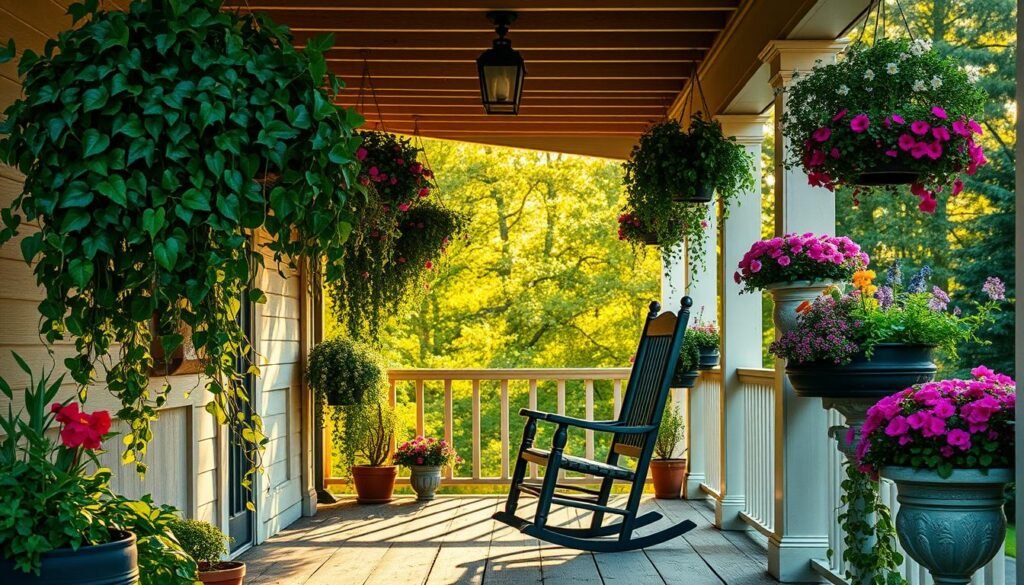Let’s face it—your current work setup might feel more like a temporary fix than a true productivity zone. Whether you’re balancing spreadsheets or editing videos, your environment directly impacts your energy and output. The secret? Intentional design that turns any area into a purpose-driven hub—even that awkward nook under the stairs.
You don’t need sprawling square footage to create a zone that works smarter. What you do need is strategic planning. We’re talking about layouts that keep essentials within arm’s reach, lighting that reduces eye strain, and storage that hides clutter without sacrificing style. (Bonus points if it sparks joy when you walk in!)
This isn’t just about aesthetics—though let’s be real, a beautiful space does make Monday mornings easier. It’s about building a sanctuary where creativity flows and deadlines feel manageable. Ready to ditch the kitchen-table chaos? Let’s explore how to blend function with personality in your work area.
Introduction: The Rise of a Small Office Home Office Design
Imagine starting your workday in a zone that actually fuels your focus. Millions have traded cubicles for curated corners where productivity meets personality—and the shift isn’t slowing down. This isn’t about makeshift setups anymore. It’s about crafting environments that adapt to how you thrive.
Understanding the Modern Workspace
Gone are rigid 9-to-5 desk prisons. Today’s work hubs prioritize flexibility—think standing desks that adjust with your energy levels or mobile carts holding your midday matcha stash. Personalization reigns supreme here. Your wall color? Mood-boosting sage green. Your chair? Ergonomic velvet. These choices aren’t frivolous—they’re productivity power-ups disguised as decor.
Why a Functional Office Matters
A well-designed area does more than look pretty. It minimizes decision fatigue by keeping essentials within reach—no more hunting for chargers during Zoom calls. Studies show organized spaces boost mental clarity by 27%. That translates to faster problem-solving and fewer “wait, what was I doing?” moments. Plus, separating work zones from living areas helps maintain boundaries when your commute is just three steps.
Your environment shapes your output more than you realize. By investing in intentional design now, you’re building a foundation for sustained creativity—and maybe even enjoying those Monday morning logins.
small office home office design: Maximizing Minimal Space
Think your square footage limits your potential? Think again. Designer Zoe Feldman insists:
“Not much space is needed for a home office—they can be surprisingly efficient.”
Even a 10×13 foot area becomes a powerhouse when every inch works smarter, not harder.
Workflow Wizardry in Tight Quarters
Melissa Oholendt’s 8×10 rule proves compact zones pack serious punch. Position your desk facing natural light. Use vertical real estate with floating shelves for reference materials. Keep daily tools on a rolling cart—your espresso machine and sticky notes become teammates.
| Layout Type | Key Elements | Productivity Boost |
|---|---|---|
| Built-In Station | Custom cabinetry, hidden outlets | 27% faster task completion |
| Mobile Setup | Fold-down desk, pegboard organizers | 19% less clutter stress |
Storage That Solves Puzzles
That awkward corner? Prime territory for triangular shelves. Desk drawers become charging stations with built-in USB ports. Magnetic panels behind monitors hold calendars and inspiration—functional decor that earns its keep.
Remember: Efficiency thrives when your environment anticipates needs. A well-planned nook doesn’t shrink your ambitions—it sharpens them.
Essential Elements for an Efficient Small Home Office
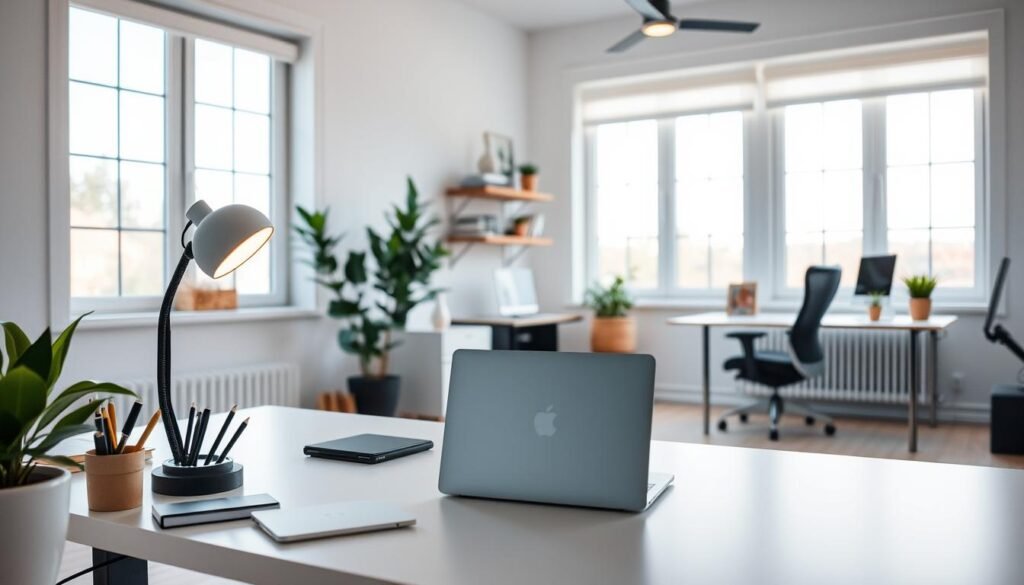
Your workspace shouldn’t feel like a compromise—it needs to actively support your best work. Four foundational pieces transform cramped corners into productivity engines: a surface that fits your workflow, smart organization systems, body-friendly seating, and illumination that keeps you sharp.
Spacious Desks and Ample Storage
Katie Schroder of Atelier Interior Design puts it plainly:
“A spacious desk and ample storage keep everything organized—like hiding papers and printers behind cabinet doors.”
But “spacious” doesn’t mean oversized. Look for surfaces that match your daily tasks:
| Desk Type | Key Features | Benefit |
|---|---|---|
| Built-In | Integrated drawers, cable management | 38% faster setup time |
| Modular | Adjustable height, removable add-ons | Adapts to creative workflows |
Pair your surface with vertical solutions. Floating shelves above eye level store less-used items, while magnetic boards corral weekly priorities.
Ergonomic Seating and Task Lighting
Zoe Feldman’s non-negotiable?
“Good task lighting and a comfortable chair aren’t luxuries—they’re tools.”
Test chairs offering lumbar supportandbreathable fabric. For lighting, consider this comparison:
| Light Type | Best For | Eye Strain Reduction |
|---|---|---|
| Adjustable LED | Detailed tasks | Up to 41% |
| Warm Ambient | Evening work | 23% less fatigue |
Position your light source opposite your dominant hand to eliminate shadows. These choices create a zone where you can power through deadlines without physical burnout.
Choosing the Best Space for Your Home Office
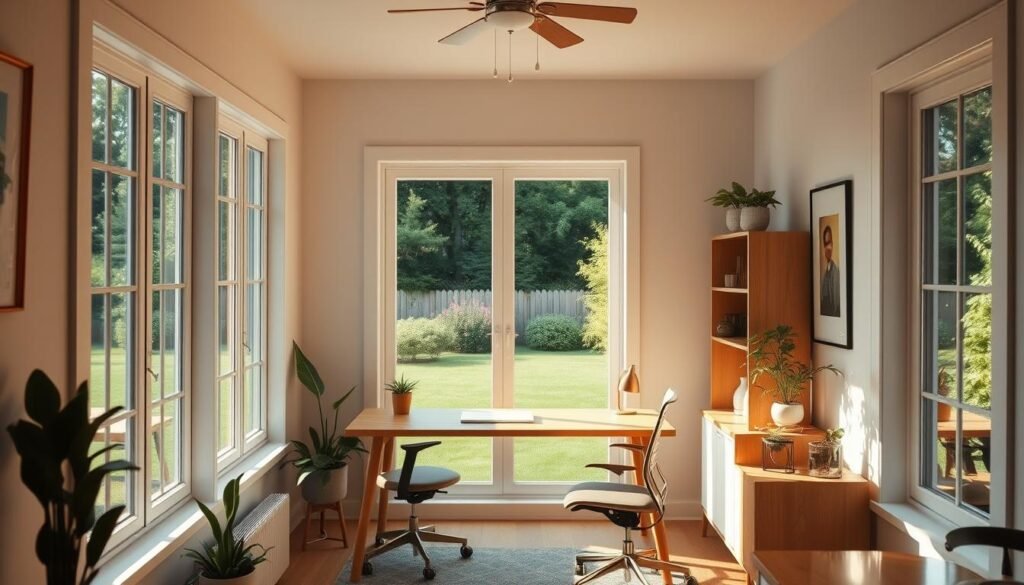
Your next productivity breakthrough might be hiding in plain sight—right under that sloped ceiling or behind a folding door. As Bethany Adams notes:
“Converting unfinished attics often beats commandeering high-traffic areas downstairs.”
Attics, Closets, and Hidden Corners
Walk-in closets aren’t just for shoes anymore. Designers like Sallie Lord prove multipurpose spaces work—she merged a laundry room with a sleek workstation. Attics offer built-in privacy (no more toddler interruptions mid-presentation), while landings become micro-offices. Rebekah Zaveloff calls these “nooks that punch above their weight.”
Evaluate candidates using this checklist:
- Lighting: Can you add task lamps or reflect natural light?
- Noise: Away from TVs or play areas?
- Airflow: Do vents or windows prevent stuffiness?
Designing Dedicated Work Zones
Even a bedroom corner can become a focused hub. Try these boundary-creating tricks:
- Room dividers with acoustic panels
- Curtains matching your decor palette
- L-shaped desks defining “work territory”
The goal? Identify underused areas that won’t disrupt daily life. That awkward closet collecting old coats? Prime real estate for your next big idea.
Innovative Storage Solutions and Multi-Functional Furniture
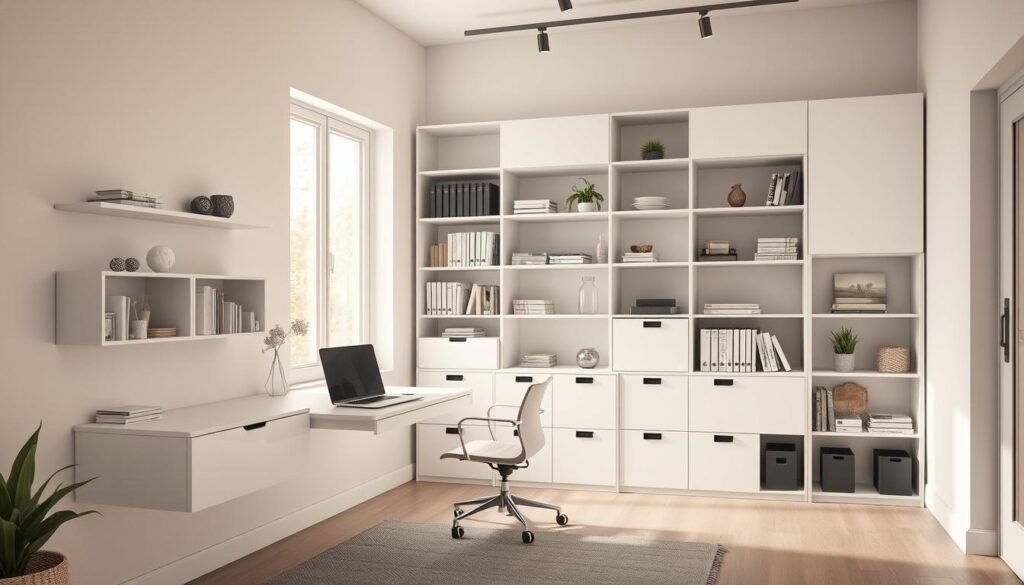
Ever found yourself tripping over cables while your notebook hides under a pile of supplies? The magic happens when your furniture works harder than you do. Let’s explore how to turn dead zones into productivity goldmines.
Built-Ins, Cabinets, and Shelving Systems
Designer Amy Oppedisano cracked the code with a closet conversion:
“Removed the doors, widened the opening, and built a desk out of cabinets just like the ones in the kitchen.”
Her approach shows how verticalwallsolutions create flow between zones. Consider these space-savers:
| Solution | Function | Space Saved |
|---|---|---|
| Floor-to-ceiling shelves | Holds files + decor | 34% more surface area |
| Magnetic panel systems | Displays notes + tools | Zero footprint |
Repurposing Unused Areas Effectively
That awkward stair landing? Prime real estate for a floating desk. Creative homeowners are turning:
- Pantries into tech hubs with fold-down desks
- Window seats into storage benches
- Bookshelves into room dividers with workspace
Multi-functional furniture seals the deal. Try ottomans hiding charging stations or chairs that moonlight as side tables. When every piece serves 2-3 purposes, your area stays clutter-free—even on chaotic Mondays.
Design Inspirations from Top Interior Designers
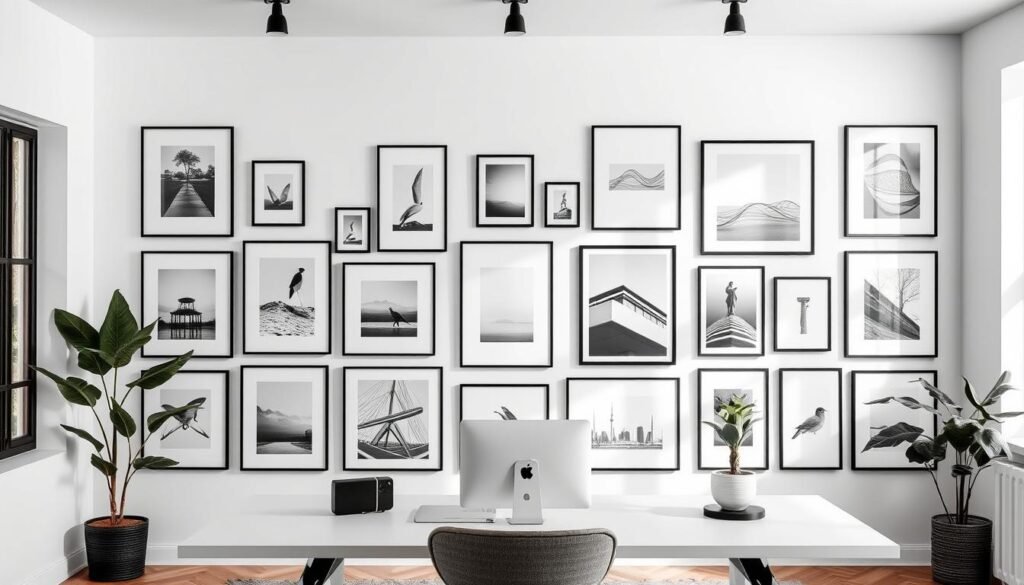
Your Zoom background just became your new business card. As Melissa Oholendt observes:
“The meeting background is still one of our most requested features.”
This shift transforms your workspace into a dual-purpose stage—expressing individuality while projecting professionalism. Let’s explore howtop interior designersbalance personality with polish.
Gallery Walls and Attractive Zoom Backgrounds
Curated displays do heavy lifting—they spark joy for you and impress colleagues. Try these layouts:
| Layout Style | Key Elements | Impact |
|---|---|---|
| Gridded Perfection | Matching frames, neutral spacing | Projects organized creativity |
| Eclectic Mix | Varying sizes, bold textures | Shows dynamic thinking |
Position your desk so natural light highlights the arrangement. Rotate pieces seasonally—framed sketches in spring, abstract prints in fall. Think of it as functional branding—a chance to showcase your taste while maintaining professionalism.
Integrating Art and Personalized Decor
Katie Schroder’s mantra applies here:
“Tailor the style to the person—joy fuels productivity.”
That vintage typewriter? Display it beside modern task lamps. Family photos? Cluster them in metallic trays. These touches create emotional anchors without clutter.
Designers suggest placing meaningful items at eye level during calls—a ceramic vase or heirloom clock becomes conversation starters. Your space should whisper your story, not shout generic trends. When decor reflects your journey, motivation flows naturally—even during marathon work sessions.
Transforming Small Spaces with Creative Ideas
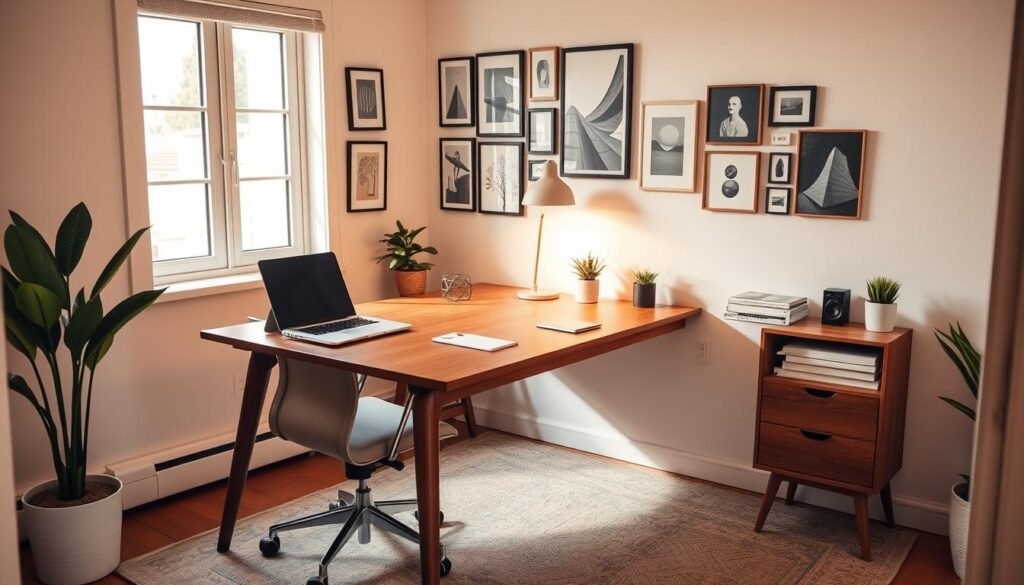
Your workspace deserves more than beige walls and generic decor. Strategic bursts of personality can elevate cramped quarters into inspiring hubs—no renovation required. Take designer Mike Moser’s approach: his cerulean Art Deco rug anchors a vintage desk setup while visually expanding the area.
Bold Rugs and Statement Accents
Moser proves floor coverings do triple duty: “A great rug defines zones, absorbs sound, and becomes instant art.” Consider these textile strategies:
| Rug Type | Visual Impact | Practical Benefit |
|---|---|---|
| Geometric Pattern | Adds modern energy | Hides crumbs between vacuum sessions |
| High-Pile Texture | Creates cozy atmosphere | Reduces chair noise on hard floors |
Pair vibrant floor pieces with minimalist furniture. A sapphire blue runner makes floating shelves pop, while burnt orange accents warm up north-facing nooks.
Wallpaper, Color, and Unique Textures
Don’t fear dark hues in tight spaces. Deep emerald grasscloth wallpaper adds depth, making walls feel farther away. For renters? Try removable murals depicting misty forests or abstract brushstrokes.
“Scenic patterns trick the eye into perceiving more square footage,” notes Boston designer Lorna Gross.
Mix matte and glossy finishes for dimension. Try chalkboard-paint door panels for spontaneous brainstorming, or lacquered cabinets that bounce light around corners. These ideas prove constraints spark creativity—your tiny command center might just become your favorite room.
Budget-Friendly Home Office Ideas You Can Try
Who says style has to break the bank? Your workspace can radiate personality and functionality without draining your savings. The trick lies in reimagining what you already own—and getting crafty with upgrades that punch above their price tag.
DIY Projects and Affordable Upgrades
Start by auditing unused spaces. That empty closet? Prime territory for a fold-down desk using salvaged wood. Designer Marissa Nelums proves it:
“A fresh coat of paint and $20 worth of brackets transformed a coat closet into my client’s favorite Zoom room.”
Multipurpose furniture stretches budgets further. Try these swaps:
| Item | DIY Version | Cost Savings |
|---|---|---|
| Floating Shelves | Sandpapered scaffold boards | 83% vs. retail |
| Cable Organizer | Upcycled cereal boxes + fabric | 100% free |
Lighting makes outsized impacts. Swap harsh overheads with secondhand lamps fitted with daylight bulbs. A $15 peel-and-stick backsplash behind your monitor adds polish instantly.
Focus on high-reward changes first. Reposition that unused bookshelf as a room divider. Dye faded curtains for a color pop. Small tweaks create momentum—and prove luxury vibes don’t require luxury prices.
Maximizing Natural Light and Creating a Fresh Vibe
What if your desk setup could boost your energy before you even sip your coffee? Research confirms access to daylight increases alertness by 15%—and your window arrangement holds the key. Let’s transform your zone into a bright sanctuary that fuels productivity from sunrise to sunset.
Optimal Window Placement and Mirror Magic
Position your desk perpendicular to windows—this reduces screen glare while bathing your workspace in soft, diffused light. Designer Laura Muller advises:
“North-facing windows offer steady illumination perfect for detail work, while east-facing ones energize morning routines.”
| Window Orientation | Light Quality | Best For |
|---|---|---|
| South-Facing | Bright, all-day | Creative brainstorming |
| West-Facing | Warm, afternoon | Client calls |
Stuck facing a blank wall? Hang a floor-to-ceiling mirror to double natural light. This trick visually expands tight areas while bouncing sunlight into shadowy corners. Pair with sheer curtains to maintain privacy without sacrificing brightness.
Lighting Solutions for a Brighter Workspace
When daylight fades, layer three light types: task lamps for focused work, ambient fixtures for overall glow, and accent lighting for visual warmth. Try this combo:
| Light Layer | Function | Example |
|---|---|---|
| Task | Reduces eye strain | Adjustable desk lamp |
| Ambient | Sets mood | Wall sconces |
Install dimmers to match your circadian rhythm—cooler tones for morning focus, warmer hues as the day winds down. Smart bulbs let you program lighting scenes that adapt to your workflow automatically. Your space becomes a living ecosystem supporting peak performance.
Clever Design Tweaks for Functional and Stylish Offices
Ever wish your workspace could vanish when the clock strikes five? Strategic styling lets your desk area multitask as both productivity hub and polished living space. These subtle tricks maintain professionalism while keeping your environment adaptable.
Camouflaging Work Zones and Hidden Desks
Designer Nick Olsen nails the art of disguise—his indigo mudcloth walls seamlessly integrate a matching blue desk. Try these stealthy solutions:
• Convert armoires into fold-down stations
• Use room dividers with built-in shelving
• Match furniture finishes to wall colors
Your tech disappears behind cabinet doors, while supplies tuck into ottomans. Work mode stays hidden until you need it.
Embracing Symmetry and Curated Collections
Balanced arrangements calm chaotic corners. Flank your monitor with identical task lamps. Display three matching ceramic vases on floating shelves. This organized approach says “I’ve got this”—even when deadlines loom.
Using Plants for Touches of Life
A trailing pothos or sculptural snake plant does more than purify air—it softens hard edges. Office spaces gain warmth when greenery frames your video calls. Pro tip: Cluster small succulents in vintage teacups for personality that thrives on neglect.
Your workspace should work as hard as you do. With these intentional tweaks, every inch serves purpose and pleasure—no corporate vibes required.

